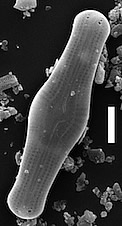Images
Click any image to enlarge...
LM image scalebar = 10 µm = 72 pixels
SEM image scalebar = 5 µm
Observations
| Observations: | Lee Stanish |
|---|---|
| Length: | 24-33 |
| Width: | 7.2-8.7 |
| Striae: | 17-20 in 10 µm at central valve, 20-22 in 10 µm near ends |
Description:
Valves are linear with a distinctly gibbous expansion in the central valve (Figs 27-32). Valve margins convex between the central area and the apices. Apices are rounded, with slightly rostrate to sub-capitate ends. Valve length 24-33 µm, valve width 7.2-8.7 µm. The axial area is narrow and linear and widens to form an elliptical central area with a rectelevatum. Striae near the central area (4-6 striae) are more widely spaced than the other striae and strongly radiate. Striae are parallel between the centre and the near the poles, and are slightly divergent at the poles (Fig. 34). Central striae 17-20 in 10 µm, distal striae 20-22 in 10 µm. Areolae near the central portion of the valve appear expanded compared to those at the poles. Two longitudinal canals are evident, positioned parallel to the raphe. The raphe is linear with the proximal raphe ends unilaterally deflected at the centre (an angle usually less than, but up to, 90° from the central axis) (Fig. 34). The position of the proximal raphe termination is variable; they may terminate within the central area or extend to the first row of areolae (Fig. 35). The two proximal raphe ends are often asymmetric in length and angle of deflection from one another. The distal raphe ends are deflected in the same direction as the proximal raphe ends. Externally, striae are primarily composed of linear, transverse areolae (Figs 33, 35). Areolae near the central area and poles may be oval to circular. The areolae bordering the distal raphe are irregularly expanded, forming 1-4 distinct canal puncta (Fig. 33).
| Morphology: | Naviculoid |
|---|---|
| Distribution: | South Victorialand endemic |
Autecology:
Notes:
Muelleria cryoconicola is abundant in a number of cryoconite holes in the Taylor Valley. Cryoconite holes are a feature of glacial ice formed by deposition of sediment the surface of glaciers by wind (Wharton et al. 1985). Small particles of sediment absorb solar radiation and melt the surrounding ice. As the ice melts, it forms holes that are filled with the melted ice and sediment. The cryoconite holes expand in size, as they serve to trap more wind-blown sediment and melt more of the surrounding ice. The cryoconite holes in the Taylor Valleys range in size from 1 meter in diameter to 60 cm in depth. These microhabitats are filled with liquid water for only a few to several weeks of the austral summer, and spend the remainder of the year in a frozen, solid state.
McMurdo Dry Valleys Waterbodies with Muelleria cryoconicola
- Bowles Creek
- Canada Stream
- Commonwealth Glacier
- Huey Creek
Original Type Description
| Author: | Stanish & Spaulding 2010 |
|---|---|
| Length: | 24-33 µm |
| Width: | 7.2-8.7 µm |
| Striae: | 17-20 in 10 µm center, 20-22 in 10 µm distal |
Original Description:
Valvae lineares parte centrale gibbosa. Margines valvae convexae intra aream centralem et apices. Apices rotundati, leviter rostrati ad subcapitatos. Longitudo 24-33 µm, latitudo 7.2-8.7 µm. Area axialis angusta, linearis, dilatata formans aream centralem ellipticam. Rectelevatum adest. Striae transapicales in area centrale distantiores, distincte radiatae, 17-20 in 10 µm. Intra aream centralem et apices, striae parallellae, leviter divergentes ad polos, 20 in 10 µm. Areolae transapicaliter elongatae, lineares, prope aream centralem leviter rotundatae, 1-4 puncta canalis adsunt. Raphe linearis, recta, terminationibus proximalibus deflexae, distalibus non bifurcates, deflixisque.
New combination
| Author: |
|---|
Citations
Index Nominum Algarum (INA):
- Original
- If an INA link is available, it will be shown above
- The INA is a bibliographic reference "card file" for algal taxonomy, containing nearly 200,000 names of algae (in the broad sense).
Publications (by year):
- Van de Vijver et al. 2009 [citation 139(138)]









